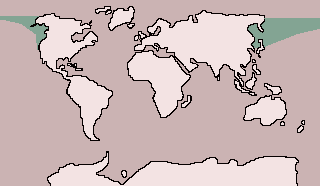Gray Whale

| Class: Mammalia:
Mammals |
Diet: Plankton |
| Order:
Cetacea: Whales |
| Size:
12.2 - 15.3 m (40 - 50 ft) |
| Family: Eschrichtidae:
Gray Whale |
Conservation Status: Lower risk - Conservation dependent |
| Scientific Name: Eschrichtius
robustus |
Habitat: coastal
waters |
| Range:
Northeastern and Northwestern Pacific Ocean |
 The
gray whale has no dorsal fin, but there is a line of bumps along the middle
of its lower back. Its jaw is only slightly arched and the snout is pointed.
Males are larger than females. Like all baleen whales, it feeds on small
planktonic animals by filtering water through rows of fringed horny plates,
suspended from the upper jaw. Any creatures in the water are caught on
the baleen plates, and the water is expelled at the sides of the mouth.
Using its tongue, the whale takes the food from the baleen to the back
of its mouth to be swallowed. The gray whale feeds at the bottom of the
sea, unlike other baleen whales, stirring up the sediment with its pointed
snout, then sieving the turbulent water. Gray whales perform migrations
of some 20,000 km (12,500 mi) between feeding grounds in the north and
breeding grounds in the south. They spend the summer months in the food-rich
waters of the Arctic, when they do most of their feeding for the year.
At the breeding grounds, they gather to perform courtship rituals, and
breeding animals pair off with an extra male in attendance. They lie in
shallow water, and as the pair mate, the second male lies behind the female,
apparently supporting her. The gestation period is 12 months, so the calf
is born at the breeding grounds a year after mating has taken place and
travels north with its mother when it is about 2 months old. The
gray whale has no dorsal fin, but there is a line of bumps along the middle
of its lower back. Its jaw is only slightly arched and the snout is pointed.
Males are larger than females. Like all baleen whales, it feeds on small
planktonic animals by filtering water through rows of fringed horny plates,
suspended from the upper jaw. Any creatures in the water are caught on
the baleen plates, and the water is expelled at the sides of the mouth.
Using its tongue, the whale takes the food from the baleen to the back
of its mouth to be swallowed. The gray whale feeds at the bottom of the
sea, unlike other baleen whales, stirring up the sediment with its pointed
snout, then sieving the turbulent water. Gray whales perform migrations
of some 20,000 km (12,500 mi) between feeding grounds in the north and
breeding grounds in the south. They spend the summer months in the food-rich
waters of the Arctic, when they do most of their feeding for the year.
At the breeding grounds, they gather to perform courtship rituals, and
breeding animals pair off with an extra male in attendance. They lie in
shallow water, and as the pair mate, the second male lies behind the female,
apparently supporting her. The gestation period is 12 months, so the calf
is born at the breeding grounds a year after mating has taken place and
travels north with its mother when it is about 2 months old.

  
|
